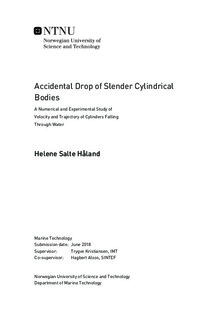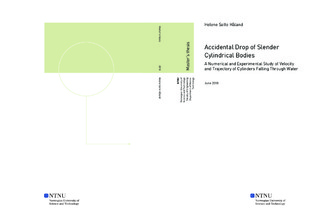| dc.description.abstract | The oil and gas industry is continuously working to improve safety and minimise risk. Numerous offshore activities involve risks that may lead to accidents with serious consequences. The risk of accidental dropped objects, e.g. related to crane operations, is one of the most common threats during offshore operations. A falling object is of concern due to human safety, the environment and dangers related to damage to subsea structures and operational equipment.
The purpose of this thesis was to analyse and investigate slender cylindrical objects behaviour, for instance drill pipes, when falling through air, entry into the water phase and their travelling through the water column. Main focus however, were on the fully submerged condition. The velocity and trajectory of falling cylindrical objects into and through the water column have been investigated through numerical calculations and experiments. The control parameters were the cylinder's physical parameters (length to diameter ratio, centre of gravity location and open or closed ends) and the initial drop conditions (drop angle and drop position).
Experiments were carried out in a 5 meter deep tank, with breadth and length equal to 6 and 12 meter. Seven 1:20 cylindrical scale models, made of steel pipes, were used. The three dimensional motion of the falling cylinders in still water were measured by the use of an under water Oqus camera system. From the experiments, six different trajectory types were found, and it was demonstrated that the centre of gravity location and the initial drop angle were the most critical factors determining the trajectories. The influence from changing the length to diameter ratio or from dropping the cylinders with open or closed ends, were also found to have an impact. For instance, it was found that cylinder excursion decrease with increasing diameter and that open end cylinders had a smaller radial excursion than cylinders with closed ends. The largest radial excursion, of approximately six meter, was found for cylinders with a small displacement in centre of gravity. This excursion was one meter larger than the water depth. The cylinder velocities were found dependent on the cylinder orientation, that showed that the viscous forces were more dominant in the lateral, than in the axial direction. Comparing the experimental results to the recommended industry practice, DNVGL-RP-F107, the recommendations for calculating object excursions were in several cases found to be non conservative.
Results from the experiments were compared to the numerical simulations that were performed based on a two dimensional maneuvering theory corrected for viscous effects. Good agreements were observed, but the similarities were found extremely dependent on the chosen value for the effective trailing edge position and the drag coefficient in the transverse cylinder direction. Several possible error sources in the experiments and weaknesses in the theory were detected. But, even though some disagreements between the simulations and the experiments were found, the simple two dimensional method gave good indications of the trajectory and velocity of cylindrical objects falling through the water column. | en |

